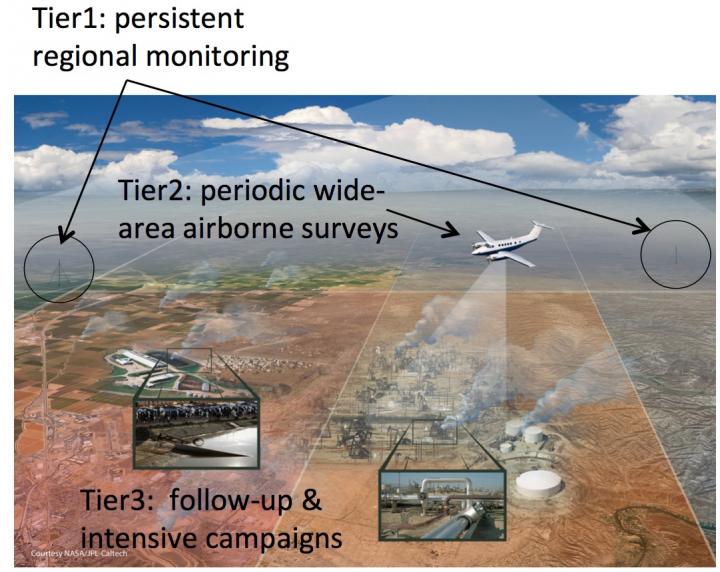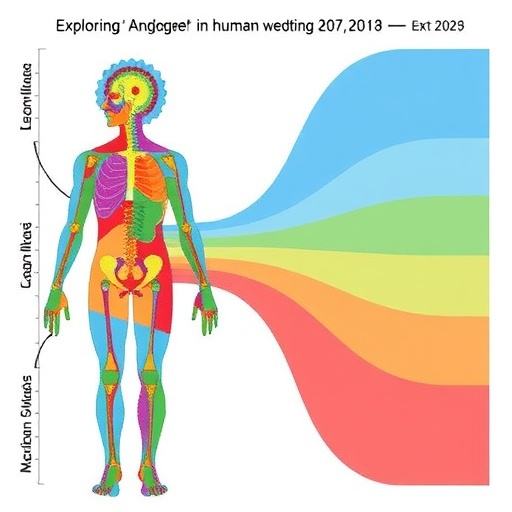A $6M grant from the California Energy Commission will go toward developing a cost-effective, scalable, emission detection approach for the state

Credit: Berkeley Lab
Methane, a potent greenhouse gas that traps about 30 times more heat than carbon dioxide, is commonly released from rice fields, dairies, landfills, and oil and gas facilities – all of which are plentiful in California. Now the Department of Energy’s Lawrence Berkeley National Laboratory (Berkeley Lab) has been awarded $6 million by the state to find “super emitters” of methane in an effort to quantify and potentially mitigate methane emissions.
With a grant from the California Energy Commission, the project will focus on the southern San Joaquin Valley, a region where the dairy industry and oil and gas industry are the dominant sources of methane. Berkeley Lab is working in collaboration with Stanford University, UC Riverside, the Central California Asthma Collaborative, Scientific Aviation, and Bluefield on the project, dubbed SUMMATION, or SUper eMitters of Methane detection using Aircraft, Towers, and Intensive Observational Network.
“The existing methane accounting and monitoring frameworks in California are limited in their ability to resolve emissions at the scale of individual cities or facilities, such as an oil and gas field or a natural gas processing facility, much less individual components,” said Sébastien Biraud, a Berkeley Lab scientist who leads the effort. “The idea for this project is based on the development of a tiered observation system.”
The researchers will be monitoring and quantifying methane emissions at multiple scales, from regional to facility and component scales. Detection methods include collecting air samples from a network of fixed towers and aircraft, running field campaigns to test new technologies including low-cost sensors, driving throughout the region using on-road vehicles equipped with a variety of equipment, and surveying residential and commercial buildings.
“We will show the state how methane emission quantification can be done over a complex region, and hopefully demonstrate that our approach can be replicated in a cost-effective manner to other areas of interest in California, such as the San Francisco Bay Area or the Sacramento region,” Biraud said. “The goal is to design a framework, show that it works, and expand it throughout the state.”
Challenges of accurate methane monitoring
Methane is classified as a short-lived climate pollutant as it stays in the atmosphere only about 10 years, while carbon dioxide, the most abundant anthropogenic greenhouse gas, stays in the atmosphere for about 100 years. California is mandated to reduce its greenhouse gas emissions under several laws and executive orders, and it has prioritized a reduction of short-lived climate pollutants as a way to make a more immediate beneficial impact on climate change and public health.
For example, California passed the California Cooling Act last year banning certain hydrofluorocarbons in new air conditioning and refrigeration systems. And following the 2015 Aliso Canyon disaster, a massive leak from a natural gas storage facility in Southern California, the state adopted an air regulation requiring quarterly monitoring of methane emissions from oil and gas wells, natural gas processing facilities, and other equipment used in the processing and delivery of oil and natural gas.
It also takes regular inventories of California’s greenhouse gas emissions, but numerous studies, including from Berkeley Lab, have found that official inventories could be underestimating methane emissions. The southern San Joaquin Valley is particularly lacking in reliable atmospheric observations of methane. Combined with the complexity of this region’s sources, this translates to significant uncertainty in the total magnitude and distribution (over space, time, and sector) of methane emissions in the region.
Most methane emissions from super emitters
The prime target of SUMMATION is big emitters. “Methane emissions could be in the form of a distributed area of small leaks, which is difficult to address, or from a large super emitter, which is low-hanging fruit,” Biraud said. “A statewide methane survey led by NASA Jet Propulsion Laboratory from 2015 through 2017 found that 80% of methane emissions in California are from 25% of sources; in some cases, as few as 1% of sources contribute more than half the emissions. A super emitter could be a dairy, it could be a landfill that’s not well maintained, or it could be a leaking natural gas compressor station.”
Having multiple collection methods, including continuous and frequent field campaigns, will improve detection and monitoring. “Many sources are not persistent – they could be on for a few months, then off,” Biraud said. “If you just do surveys one or two times a year, you’re fishing. You might see a source, you might not. With a persistent network of towers, you address the nature of intermittent sources.”
The SUMMATION team will use tracers to help attribute the source of methane. For example, certain alkanes (like ethane) are present in methane from oil and gas operations but not present in methane from dairy operations.
One key component of the project is to evaluate low-cost methane sensors. “There are new technologies emerging,” Biraud said. “We’ll invite companies to participate, then deploy some of them over a one-year period.”
With observations and data analysis from the tiered observation system framework developed in Kern County, Berkeley Lab researchers will perform an economic analysis, looking at cost-effective ways to deploy some of these technologies to address certain questions in other parts of the state.
Another important aspect of the project includes stakeholder and community engagement. “We’ll be reaching out to disadvantaged communities, both to educate them on methane emissions and also to hear about their concerns in order to inform the development of future measurement systems,” Biraud said. “These communities are affected disproportionately by methane and VOCs [volatile organic compounds].”
###
Founded in 1931 on the belief that the biggest scientific challenges are best addressed by teams, Lawrence Berkeley National Laboratory and its scientists have been recognized with 13 Nobel Prizes. Today, Berkeley Lab researchers develop sustainable energy and environmental solutions, create useful new materials, advance the frontiers of computing, and probe the mysteries of life, matter, and the universe. Scientists from around the world rely on the Lab’s facilities for their own discovery science. Berkeley Lab is a multiprogram national laboratory, managed by the University of California for the U.S. Department of Energy’s Office of Science.
DOE’s Office of Science is the single largest supporter of basic research in the physical sciences in the United States, and is working to address some of the most pressing challenges of our time. For more information, please visit science.energy.gov.
Media Contact
Julie Chao
[email protected]
Original Source
https:/





